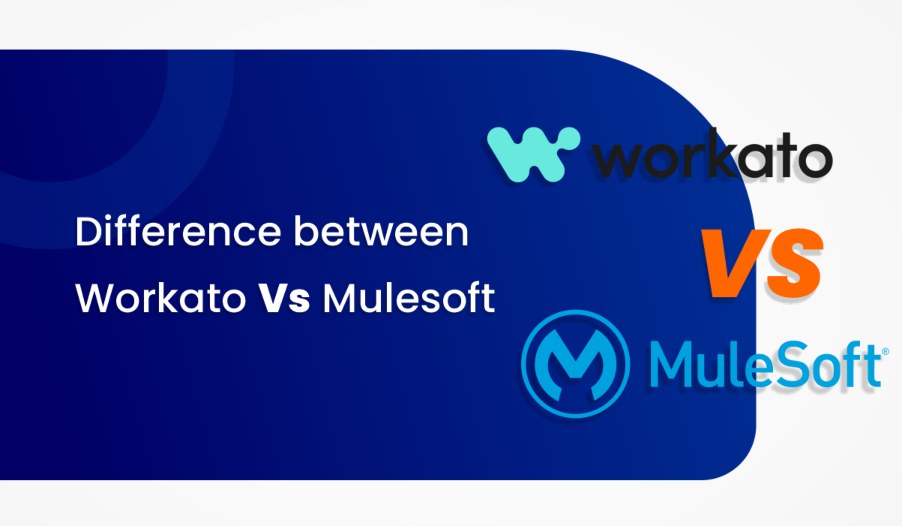Workato vs Mulesoft
Nowadays in the digital world, integration is booming and becoming crucial for all businesses. The ability to connect different systems and applications is essential for streamlining workflows, reducing errors, and maximizing productivity.
However, there are a plethora of integration platforms available in the market, and it can be challenging to choose the right one for your business needs. So, to sort out the things, we will compare two of the leading integration platforms, and help you decide which one is the best fit for your organization. So, why wait? Let’s jump into the topic of Workato vs Mulesoft.
Key Features
Mulesoft and Workato, both of them are powerful integration platforms that provide numerous features to help businesses to well-organize their workflows and connect their systems as well as applications. Here are some of the key features of each platform:
Workato:
Automated Workflows: Workato offers numerous automation tools with the help of which any business can create automated workflows. Moreover, they can connect to different systems and applications without writing any hectic code.
AI-Powered Automation: This platform uses AI and machine learning to automate complex business processes and make data-driven decisions.
Pre-Built Integrations: Workato also provides a library of pre-built integrations with popular business applications such as Salesforce, Zendesk, and Slack.
Integration Recipes: The integration recipes of Workato gives the power to a business so that they can easily connect different systems and applications to automate common workflows.
Mulesoft:
Anypoint Platform: Mulesoft’s flagship product, Anypoint Platform, is a comprehensive integration platform that offers a range of features including data integration, API management, and analytics.
Data Integration: It offers a variety of data integration tools that allow businesses to easily connect with different databases, systems, and applications to transfer data between them.
API Management: Mulesoft also provides advanced API management tools that allow businesses to design, build, and manage APIs, as well as control access to them.
Real-Time Analytics: This platform’s major benefit is its real-time analytics which allows businesses to monitor and analyze their integration flows, detect issues, and optimize performance.
Integration Capabilities
Both Workato and Mulesoft, offer excellent integration capabilities, although their approach toward integration is different.
Workato
Workato is an all-in-one platform that provides both integration and automation capabilities. Its integration capabilities are designed to be user-friendly and intuitive, allowing users to build complex integrations without writing any code.
Workato offers a huge number of pre-built connectors to popular business applications, databases, and APIs, that allow users to create custom connectors as well.
Mulesoft
Mulesoft, on the contrary, is an API-led integration platform that provides tools for building, managing, and securing APIs. It is designed to be highly scalable and can handle even the most complex integration scenarios.
Mulesoft offers different integration tools, including a graphical integration designer, and pre-built connectors to various systems. It also comes with a powerful API gateway that provides security, analytics, and policy management capabilities.
Ease of Use
When it comes to ease of use, both platforms have different approaches.
Workato
Workato is designed to be a no-code integration platform, meaning that users can create integrations without having to write any code. The platform uses a drag-and-drop interface that allows users to create integration workflows by visually connecting different apps and services.
It clearly indicates that the interface is intuitive and user-friendly, and the platform provides step-by-step guidance to help users build integrations quickly.
Mulesoft
On the other hand, Mulesoft requires some level of technical expertise to use it more efficiently. The platform provides a graphical interface for building integrations, but it also requires users to write code to customize and extend the platform’s capabilities.
While Mulesoft does provide a range of tools and resources to help users get started, it can take some time to learn how to use the platform effectively.
Pricing
Both of them provide different pricing structures, and here we mentioned their pricing plan.
Workato
- Workato offers four pricing plans: Free, Basic, Professional, and Enterprise.
- The Free plan is limited to 100 actions per month, while the other plans offer unlimited actions.
- The Basic plan starts at $599/month and includes up to 5,000 actions per month and email support.
- The Professional plan starts at $1,499/month and includes up to 25,000 actions per month, premium support, and additional features such as priority processing and custom branding.
- The Enterprise plan is customizable and offers unlimited actions, premium support, and advanced features such as custom security and compliance.
Mulesoft
- Mulesoft offers a variety of pricing options, including both subscription and perpetual licensing.
- Pricing varies based on the number of cores, connectors, and other features needed.
- For example, the MuleSoft Enterprise subscription starts at $120,000 per year for up to 8 vCores and includes features such as API design and management, data integration, and analytics.
- Perpetual licensing is also available, with prices starting at $56,000 per vCore.
Use Cases
The use cases of both these integration platforms are different, and we have mentioned them briefly.
Workato
- Workato is a cloud-based integration platform that mainly specializes in automating workflows and integrating cloud applications and services.
- Workato’s key use cases include automating business processes, integrating cloud applications, and creating custom integrations between different systems.
- It is often used by small to medium-sized businesses and departments within larger enterprises to automate manual tasks, improve efficiency, and increase productivity.
Mulesoft
- Mulesoft is an enterprise-level integration platform that focuses on API-led connectivity and integration.
- Mulesoft’s key use cases include integrating legacy systems, connecting disparate systems and data sources, and building APIs to enable access to data and services across an organization.
- Mulesoft is often used by large enterprises with complex IT infrastructures, as well as by organizations that require advanced integration capabilities, such as financial services, healthcare, and government sectors.
Pros and Cons
Workato vs Mulesoft have numerous advantages, but they also have some loopholes. So here in this part, we mentioned their pros and cons.
Workato
Pros:
- Easy to use and learn
- Affordable pricing plans
- Wide range of integrations and automation capabilities
- Excellent customer support
Cons:
- Limited customization options
- May not be suitable for large enterprises
- Occasional glitches or issues
Mulesoft
Pros:
- Highly flexible and customizable
- Advanced integration capabilities and API-led connectivity
- Excellent security and compliance features
- The large and active community of users and developers
Cons:
- Higher cost compared to some other integration platforms
- Steep learning curve
- May not be suitable for smaller organizations
Alternatives
Both of these platforms offer different benefits, and therefore there are several other platforms that provide the same service as them. Here we have mentioned some Workato alternatives and Mulesoft alternatives.
Workato Alternatives
- Zapier
- Microsoft Power Automate
- Integromat
- Tray.io
- Automate.io
Mulesoft Alternatives
- Dell Boomi
- IBM App Connect
- Talend
- Jitterbit
- SnapLogic
Last Minute Advice
When we compared these two platforms’ integration capabilities, we found that both of them are helpful in increasing workflows, automating tasks, and improving efficiency. While Workato may be more suitable for smaller organizations with simpler integration needs, Mulesoft is better equipped to handle complex integration scenarios and enterprise-level requirements. So, we can’t say that Mulesoft is one of
Workato’s competitors.
Ultimately, the choice between the two platforms will depend on the specific needs and budget of the organization. So, whether you’re just starting out or looking to level up your integration game, Workato vs Mulesoft: two of the leading integration platforms in the market today.

 +1 561 220 0044
+1 561 220 0044 +61 255 646464
+61 255 646464 +91 909 080
3080
+91 909 080
3080

